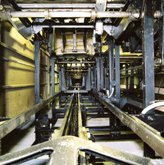How to reconstruct dispersed libraries…
 from Marie-Eugénie Lecouffe (ENSSIB and CSB intern)
from Marie-Eugénie Lecouffe (ENSSIB and CSB intern)
The conference “How the secularization of religious houses transformed the libraries of Europe, 16th-19th centuries” took place in Oxford from the 22nd to the 24th of March 2012 . During these three days, speakers from thirteen different countries worldwide painted a picture of the impact of religious houses’ closure all over Europe from 16th to 19th century on the fate of monastic libraries and their collections.
Some of these manuscript and printed books have been lost, some others preserved. Some of them have been kept in public libraries – which have sometimes been founded at that point –, some others sold to private collectors. The result is: these collections are dispersed today…
But more and more attention is now paid to studying provenance evidence, and tools have been developed to allow the reconstruction of former libraries. A few of them were presented during the conference: Ricerca sull’Inchiesta della Congregazione dell’Indice dei libri proibiti (RICI); Material Evidence in Incunabula (MEI); Index Possessorum Incunabulorum (IPI); CERL Thesaurus (CT); Early Book Owners in Britain (EBOB); Medieval Libraries of Great Britain (MLGB3). We’ll focus here on the ones which anybody can actually use on the Internet. Indeed EBOB and MLGB3 – which is an electronic updated version of Neil Ker’s Medieval libraries of Great Britain – are still works in progress and will only be available later.
RICI’s resource:
Le biblioteche degli ordini regulari alla fine del secolo XVI
This databank contains the transcription of lists of books owned by member of Italian convents and monastery and acquired by the S. Congregazione dell’Indice dei libri proibiti from the publication of the Index librorum prohibitorum by pope Clement VIII in 1596 until 1603. These lists are today preserved in the codici Vaticani latini 11266-11326 and concern libraries of 31 male religious orders or books used by some of their individual members.
It allowes search into libraries (by Vatican manuscript, list, location or person) as well as bibliographical research (by author, title, publication date or edition). It’s also possible to combine both approaches. The access to the databank is free, although it requires a registration.
CERL’s resources:
The Consortium or European Research Libraries shares several resources to help searching into provenance information – which often are in catalogues entries as membra disjecta – and reconstructing former libraries.
CERL Thesaurus
The varying names of places and persons depending on countries are an important issue for anyone interested in the period of hand press printing (1450-c. 1830). CERL provides a thesaurus of printing places, 700,000 personal names and 10,000 institutional names.
Each record gives besides the various names in different languages some biographical information, if it’s a personal name, pictures of the devices, if it’s a printer’s name, links to catalogues of the library where books are held today, if it’s previous owner name, georeferences, if it’s a place’s name. .
CERL member libraries as well as other libraries or projects are contributing to these authority files which enable to know which authority forms are used by which library. The CERL Thesaurus links together informations which otherwise would be dispersed.
Material Evidence in Incunabula
Created two years ago, this resource aims to trace the circulation and use of incunables across Europe. Through MEI, which is linked to the Incunabula Short Title Catalogue (ISTC), one can search not only bibliographical records but also copy-specific notes. As far as possible, provenance evidences are geographically and chronologically identified and the previous owners are socially characterized. Of course links to CERL Thesaurus allow further biobibliographical research.
Index Possessorum Incunabulorum
This index contains all the entries extracted by Paul Needham (Librarian of the Scheide Library, Princeton University Library) from 200 published catalogues of incunables and up-dated through his own research. It’s the best way to start a resarch for reconstructing a collection. For example the five case studies about evidence and provenance histories of monastic books now in the Bodleian Library, published on this blog before the conference, base their lists of place where incunabula with the same provenance can be found today mostly on Paul Needham’s IPI.
What’s on the Bodleian Library?
All these initiatives must stimulate libraries more than ever to record and deliver the results of provenance research: they are now able to link different information together and to supply pictures… and pictures are often the easiest way to provide a “description” of provenance evidence and to make the connection between two unidentified monograms or coats of arms for example… Making provenance information available for users is the topic I’m now dealing with in the Bodleian Library.
Besides the provenance index of the Bodleian Incunable Catalogue which gives access to extended provenance information for Bodleian incunables, the card index created by the former antiquarian books librarian David M. Rogers (1917- 1995) is the main resource for provenance of the early printed books in Bodleian collections, that still remains outside the rare books catalogue records in the online catalogue.
The cards provide name of the previous owner, institutional or individual, some brief information about this one, the shelfmarks of the Bodleian books from this provenance and the description of the evidence. Sometimes a picture is supplied, as in the example shown here.
Inspired by the pictures on these cards, and by the example of other libraries, I’ve been taking pictures of provenance evidence in early printed books. The pictures which I’ve taken until now are shown, as an experiment, on flickr. It allows, among other things, the grouping together in sets of all the unidentified monograms or coat of arms, for example. I’m also thinking about the right way of supplying a short description with the picture (what information is essential?) and I’m trying to adopt some “standards” in these descriptions (from that point of view CERL’s resources are really helpful).
To conclude, I would just write: to be continued…





Comments are closed.